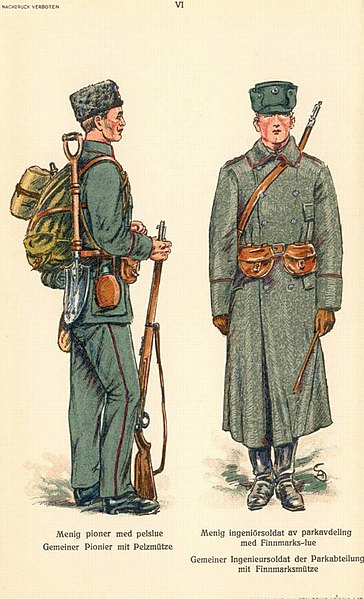File:NORWAY ARMY UNIFORMS 1932 DEN NORSKE HÆR uniformer Forsvarsdep. Norweg. Heer Verlag Moritz Ruhl 21 VI PIONIER Pelzmutze SOLDAT Finmarkslue Artist A Sassmann unident. death active until c 1934 Norw. Ministry of Defence approved No know.jpg

Original file (1,420 × 2,338 pixels, file size: 615 KB, MIME type: image/jpeg)
Captions
Captions
Summary edit
| DescriptionNORWAY ARMY UNIFORMS 1932 DEN NORSKE HÆR uniformer Forsvarsdep. Norweg. Heer Verlag Moritz Ruhl 21 VI PIONIER Pelzmutze SOLDAT Finmarkslue Artist A Sassmann unident. death active until c 1934 Norw. Ministry of Defence approved No know.jpg |
English: DEN NORSKE HÆR / Das Norwegische Heer published by Verlag von Moritz Ruhl, a former publising company in Leipzig, Germany c. 1932, a booklet on the uniforms and flags of the Norwegian Army, approved by the Norwegian Ministry of Defence (Det Kongelige Norske Forsvarsdepartementet). Illustrated with coloured uniform drawings by major Anton Sassmann (Anton Saßmann), a German military artist with unidentified year of death, active until around 1934. Text in Norwegian, picture captions in Norwegian and German. No known copyright restrictions. Low resolution image of a cropped version of the scanned page from the book.
Norsk bokmål: DEN NORSKE HÆR / Das Norwegische Heer utgitt av Verlag von Moritz Ruhl i Leipzig, Tyskland ca. 1932, et hefte om den norske hærens uniformer, flagg og faner, godkjent av Det Kongelige Norske Forsvarsdepartementet. Illustrert med uniformstegninger i farger utført av major Anton Sassmann, en tysk militærmaler med uidentifisert dødsår, aktiv til rundt år 1934. Tekst på norsk, bildetekst på norsk og tysk. Lavoppløst bilde av en beskåret versjon av den innskannede sida fra boka. Ingen kjente opphavsrettsbegrensninger.
|
| Date | |
| Source |
English: DEN NORSKE HÆR / Das Norwegische Heer, booklet on the uniforms and flags of the Norwegian Army, published by Verlag von Moritz Ruhl, a former publishing company in Leipzig, Germany, c. 1932. Publication approved by the Norwegian Ministry of Defence (Det Kongelige Norske Forsvarsdepartementet)
Norsk bokmål: Elektronisk kopi i høyere billedoppløsning i Nasjonalbibliotekets Nettbibiloteket: Anton Saßmann: Den Norske hær : organisasjon, bevæbning og uniformsbeskrivelse (Ruhl, 1932) |
| Author | Uniform and insigia drawings by major Anton Sassmann/Saßmann (pseudonym for Anton Sussmann, 1867-?), Austrian military artist with unidentified year of death, active until the 1930s. No known copyright restrictions. |
Licensing edit
- You are free:
- to share – to copy, distribute and transmit the work
- to remix – to adapt the work
- Under the following conditions:
- attribution – You must give appropriate credit, provide a link to the license, and indicate if changes were made. You may do so in any reasonable manner, but not in any way that suggests the licensor endorses you or your use.
- share alike – If you remix, transform, or build upon the material, you must distribute your contributions under the same or compatible license as the original.
| Public domainPublic domainfalsefalse |
|
This work is in the public domain in its country of origin and other countries and areas where the copyright term is the author's life plus 70 years or fewer.
| |
| This file has been identified as being free of known restrictions under copyright law, including all related and neighboring rights. | |
https://creativecommons.org/publicdomain/mark/1.0/PDMCreative Commons Public Domain Mark 1.0falsefalse
File history
Click on a date/time to view the file as it appeared at that time.
| Date/Time | Thumbnail | Dimensions | User | Comment | |
|---|---|---|---|---|---|
| current | 21:57, 3 October 2022 |  | 1,420 × 2,338 (615 KB) | Wolfmann (talk | contribs) | Uploaded a work by Drawings of uniforms and insignia by major Anton Sassmann, a German military artist with unidentified year of death, active until around 1934. No known copyright restrictions. from ''DEN NORSKE HÆR / Das Norwegische Heer'', booklet on the uniforms ad flags of the Norwegian army, published by Verlag von Moritz Ruhl, a former publishing company in Leipzig, Germany, c. 1932. Publication approved by the Norwegian Ministry of Defence (Det Kongelige Norske Forsvarsdepartementet)... |
You cannot overwrite this file.
File usage on Commons
There are no pages that use this file.
Metadata
This file contains additional information such as Exif metadata which may have been added by the digital camera, scanner, or software program used to create or digitize it. If the file has been modified from its original state, some details such as the timestamp may not fully reflect those of the original file. The timestamp is only as accurate as the clock in the camera, and it may be completely wrong.
| Horizontal resolution | 200 dpi |
|---|---|
| Vertical resolution | 200 dpi |
| Color space | sRGB |